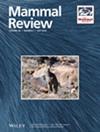Research Trends on Bats in Morocco: An Overview, Focusing on Gaps and Threats to Species Conservation
IF 4.4
2区 生物学
Q1 ECOLOGY
引用次数: 0
Abstract
- Moroccan bats are extensively studied in North Africa due to their ecological sensitivity, significant threats and increased field investigations related to wind energy development.
- This review updates the list of bat species, identifies key threats and examines research distribution patterns over time, regions, research topics, taxa and endemicity, highlighting gaps and setting future research priorities.
- Between 1897 and 2024, around 136 information sources were produced, categorised into five research periods: four lasting about 30 years each and the fifth covering 2020–2024. These researches were analysed based on temporal, regional, topical, taxonomic and endemic trends.
- The most recent revision of Moroccan bats identified 29 species. With the addition of two new species and the renaming of one species, the current inventory now includes 31 species across eight families, three of which are endemic.
- Research efforts varied over time, with ‘taxonomy and systematics’ being the most studied topic, focusing on classification, evolutionary relationships and species identification. Three genera (Rhinolophus, Myotis and Pipistrellus) appeared in 56% of the studies. Investigations cover progressively a wide geographic range, with a clear preference for Northern regions. However, topics like ‘diseases’ and ‘conservation’ were addressed in less than 10% of articles.
- To address major research gaps, we recommend in-depth studies on bat phenology, parasitology, habitat preferences and migrations. Special attention should be given to the causes of species decline, in both population size and geographical extent, focusing on habitat loss, human disturbances, individuals harvesting and possibly wind farms.
- Crucial research needs are identified for 10 prior species: Plecotus gaisleri, Miniopterus maghrebensis, Myotis capaccini, Rhinolophus mehelyi, Rhinolophus euryale, Miniopterus schreibersii, Myotis zenatius, Nyctalus lasiopterus, Barbastella barbastellus and Rhinolophus blasii.


摩洛哥蝙蝠的研究趋势:综述,重点关注物种保护的差距和威胁
摩洛哥蝙蝠因其生态敏感性、重大威胁和与风能开发相关的实地调查增加而在北非得到广泛研究。本综述更新了蝙蝠物种清单,确定了主要威胁,并检查了随着时间、地区、研究主题、分类群和地方性的研究分布模式,突出了差距并确定了未来的研究重点。1897年至2024年间,大约产生了136个信息来源,分为五个研究阶段:四个研究阶段各持续约30年,第五个研究阶段涵盖2020年至2024年。根据时间、区域、局部、分类和流行趋势对这些研究进行了分析。最新的摩洛哥蝙蝠鉴定出29种。随着两个新物种的加入和一个物种的重新命名,目前的物种清单包括8个科的31个物种,其中3个是地方性的。研究工作随着时间的推移而变化,“分类学和系统学”是研究最多的主题,重点是分类、进化关系和物种鉴定。3个属(Rhinolophus, Myotis和Pipistrellus)出现在56%的研究中。调查逐渐覆盖广泛的地理范围,显然优先考虑北部地区。然而,像“疾病”和“保护”这样的话题在不到10%的文章中得到了讨论。为了解决主要的研究空白,我们建议深入研究蝙蝠物候学、寄生虫学、栖息地偏好和迁徙。应特别注意物种减少的原因,包括种群数量和地理范围,重点是生境丧失、人类干扰、个体收获和可能的风力发电场。确定了10个现有物种的关键研究需求:gaislectus、maghrebensis、capaccini Myotis、mehelyi rhinopus、euryale rhinopus、schreibersiminiopterus、zenatius、lasiopterus、Barbastella barbastellus和blasii Rhinolophus。
本文章由计算机程序翻译,如有差异,请以英文原文为准。
求助全文
约1分钟内获得全文
求助全文
来源期刊

Mammal Review
生物-动物学
CiteScore
12.20
自引率
4.10%
发文量
29
审稿时长
>12 weeks
期刊介绍:
Mammal Review is the official scientific periodical of the Mammal Society, and covers all aspects of mammalian biology and ecology, including behavioural ecology, biogeography, conservation, ecology, ethology, evolution, genetics, human ecology, management, morphology, and taxonomy. We publish Reviews drawing together information from various sources in the public domain for a new synthesis or analysis of mammalian biology; Predictive Reviews using quantitative models to provide insights into mammalian biology; Perspectives presenting original views on any aspect of mammalian biology; Comments in response to papers published in Mammal Review; and Short Communications describing new findings or methods in mammalian biology.
 求助内容:
求助内容: 应助结果提醒方式:
应助结果提醒方式:


